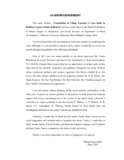Please use this identifier to cite or link to this item:
https://elibrary.tucl.edu.np/handle/123456789/3521| Title: | Potentialities of Village Tourism (A Case Study in Kuibheer Region of Ilam District) |
| Authors: | Limbu, Matap Singh |
| Keywords: | Villages;Tourism |
| Issue Date: | 2011 |
| Publisher: | Department of Rural Development |
| Institute Name: | Mahendra Ratna Multiple Campus, Ilam |
| Level: | Masters |
| Abstract: | Village tourism is a newly emerging concept where the visitor can really experience with the village life style and environment. Village tourism is a means of sustainable tourism development, it refers to tourists staying in or near village, of traditional village in remote areas and learning about the village way of life. This kind of tourism involves provision of local style accommodation, locally produced food items on tourists and the organizations of tourist participation in village activities. This study gives the real picture of tourism potentialities in Kuibheer region of Ilam District. Among the various tourism areas in Ilam, Kuibheer region of Chamita VDC is also one of the potential tourism area. Views of Sunrise and Majestic Himalays, Deumai Pokhari and its Surrounding Community Forest and Pasture land, Sight seeing, Seasonal trekking, Paragliding, Rock Climbing, Scenic beauty, Flora and Fauna Cultural diversity etc. are main tourism products of Kuibheer region. The objectives of the study are to identify the existing major tourism products of the Kuibheer region, to explore the potential tourism products in Kuibheer region and to explore the Kuibheer region as a major tourism destination of Ilam. Therefore, this study is helpful for those people who take interest in Village based tourism development planners as well as local planners to emphasis upon it. The study is based on both primary and secondary data. More specifically, it is based on primary data and information which is collected by researcher himself with the help of different data collection tools and technique. 50 households and 8 hotels were taken for sample size from Kuibheer region and 20 tourists of different countries are also interviewed. For this purpose simple random sample random sampling method has been used in survey of tourism and households and purposive sampling method has been applied for hotel survey. However, secondary source of data and information has been used wherever they needed. Kuibheer region has enormous tourism products to attract the tourist. It has a god gifted natural asstes like Kuibheer rock, Kuibheer Danda, Dumai Muhan (origin place of Deumai river), scenic beauty, views of sunrise and Himalayas and etc. which will be the great interest for the tourist. But there are so many problems to develop tourism due to the lack of basic infrastructures. The existing 8 local level hotels with poor facilities are not sufficient to provide the services for present demands of tourists. In 2010, 73.07% tourists stayed at hotel only one day /night that is very short. In present time hoteliers are benefited mainly by the domestic tourists. This area is visited by different countries tourists but the domestic tourists share is dominant (70%). Tourist's view of tourism development in this area is optimistic. There is good possibility of tourism in and around the Kuibheer region in near future. Although, sample tourists evaluate most of the existing infrastructure are in bad condition. Ethnic diversity is found in the study area. Historical tribes Sherpa and their culture are one of the attractions for tourists. Among 50 sampled household 44% are Rai and agriculture is the main occupation of 70% sampled household's population. There is lack of well - equipped hotels to stay in the study area but the local community is providing home service providing capable houses are found about 64 in Kuibheer region. In the view of its potential for the tourism development, local community seen to be more interested to develop this area jointly as a tourist destination. They see the good prospects of tourism in future. The main problems associated with tourism in the study area are lack of transportation, accommodation, skilled manpower, effective tourism plan, security service, advertisement, publicity and etc. Thus it is necessary for the development of tourism infrastructures to develop tourism in the study area as shown by the output of the research. |
| URI: | http://elibrary.tucl.edu.np/handle/123456789/3521 |
| Appears in Collections: | Rural Development |
Files in This Item:
| File | Description | Size | Format | |
|---|---|---|---|---|
| matap cover.pdf | 1.46 MB | Adobe PDF |  View/Open | |
| matap thesis.pdf | 515.79 kB | Adobe PDF |  View/Open |
Items in DSpace are protected by copyright, with all rights reserved, unless otherwise indicated.
